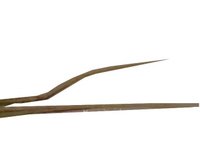slender wild oat, Avena barbata, February-June, Europe
Among the most abundant and widespread grasses that make California’s hills “golden,” wild oat (A. fatua) and slender wild oat (A. barbata) cover lowland California west of the Sierra and southern deserts. While not found in adobe bricks of some of the state’s oldest buildings, wild oat probably arrived soon after the time of European settlement of California in 1769. See the posting "Replacement of the Native Vegetation."
Cluster and Allard (1995) write:
Historical records indicate that Avena barbata was introduced to California from Spain (Robbins 1940) . The first introductions probably occurred during the Spanish-Mexican colonial period (1769-1846), but Avena barbata did not become a major component of the flora in all areas with Mediterranean-like climates until cerealMinnich (2008) considers Avena barbata a member of the late-19th century suite of invaders including farmers foxtail, ripgut brome and red brome. Though present earlier he argues that these second wave exotics began dominating California valley and foothill grasslands 1890-1920s, citing numerous cintemporaneous sources (Minnich, p. 186).agriculture spread throughout California in the mid-19th century.
Burcham (1957) writes:
Accounts of travelers contain records of the widespread distribution of some of the most important introduced plants at a comparatively early period. Traversing a portion of the central San Joaquin Valley in 1833, Zenas Leonard remarked, "This day our course lay through a large prairie covered with wild oats—which at this season of the year when nothing but the stock remains, has much the appearance of common oats" (Leonard, 1934). There is a possibility that a person unfamiliar with the vegetation of California crossing this region in November when only stalks of the grasses remained—and this was the situation with Leonard—may have confused wild oats with needlegrass; but this possibility is hardly plausible in view of his later experience in the State. Leonard also described large areas covered with wild oats in the valley north of Mission San Juan Bautista and elsewhere in the Coast Ranges. During his visit to California in 1841, Wilkes (1845) noted about San Pablo Bay and the Carquinez Straits that "the hills are thickly covered with wild oats"; the country about San Francisco presented a rather singular appearance, he said, due to the color of wild oats when ripened. Bryant (1848) refers to the occurrence of wild oats many times in the account of his travels in California in 1846 and 1847; crossing the bottomlands of the Mokelumne River, along its lower reaches, he remarked: "We passed through large tracts of wild oats during the day; the stalks are generally from three to five feet in length." Bryant described the Santa Clara Valley between San Jose and San Francisco as "a flat plain . . . covered with a great variety of grasses, wild oats, and mustard. So rank is the growth of mustard in many places, that it is with difficulty that a horse can penetrate through it." In 1851 the party of Col. Eedick M'Kee found wild oats growing abundantly on the foothills from Santa Rosa northward into the Russian River Valley; they were not noted north of the divide between Russian and Eel Rivers by that party (Gibbs, 1860).Avena fatua and A. barbata awns are attached on the back of its lemmas; with a hand lens observe that the awn is a continuation of the midnerve (vascular bundle), and that the lemma is nerveless above. The awn is an adaptation that assists seed dispersal. Purple needlegrass also has a conspicuous, self-drilling, moisture-driven, hygroscopic awn, as does the ubiquitous forb storksbill, whose drill is actually its long, sharply-pointed persistent style column attached to the ripe fruit.
It is probable that Russian settlers at Fort Ross were first to introduce wild oats and mustard, and other plants, north of San Francisco Bay. During the period of their occupation of Fort Ross, Russian writers noted that mustard grew wild in many places, requiring no cultivation; in various years from 100 to 200 pounds of seed was gathered and sent to Sitka (Khlebnikof, 1835). "In 1833 wild oats made its appearance in many fields in such abundance as to smother the wheat and the only means to suppress it was to pasture cattle on the fields for several years ..." (Tikhmenef, 1861-63). Obviously seed of mustard and wild oats—as well as other alien plants—were introduced as impurities in crop plants, many of which had been obtained directly from the Spaniards (Essig, 1933). Infestations of the magnitude reported by these writers would indicate introductions within a short time after founding of the colony.
Cultivated oat (A. sativa) is an occasional escape from birdseed, but doesn't persist. California wild oatgrass is a species of the genus Danthonia.
Name: Latin for oat | simple.
BURCHAM, LT. 1957. California Range Land: An Historico-Ecological Study of the Range Resource of California. Davis [Calif.]: University of California, 1957.
CLUSTER, PD; ALLARD, RW. Evolution of Ribosomal DNA (rDNA) Genetic Structure in Colonial Californian Populations of Avena barbata. " Genetics 139: 941-54.
MINNICH, RA. 2008. California's Fading Wildflowers: Lost Legacy and Biological Invasions. UC Press.


Illustrations of lemma tips of slender wild oat (attenuate to 4 mm l awns); and wild oat (short teeth), far left